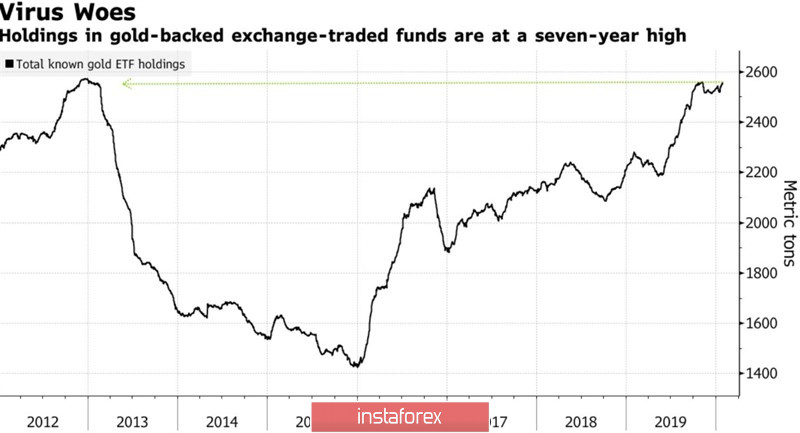The confident pace of the US dollar and Beijing's assurances that it will win the coronavirus somewhat cooled the ardor of the "bulls" for XAU/USD, however, it did not sow panic in their ranks. The peak of the epidemic has not yet been reached, and the first inversion of the US yield curve since October increases the risks of Jerome Powell's "dovish" rhetoric at a press conference following the January FOMC meeting. The short-term prospects for gold still look optimistic, however, the situation may change in the medium-term investment horizon.
The precious metal has fallen to 7-year highs twice since the beginning of 2020 due to concerns about a slowdown in the global economy. First, the conflict in the Middle East inflated oil prices, which should have harmed the economies of countries that import black gold. Coronavirus, on the other hand, lowered the Brent and WTI quotes, while rumors of a slowdown in global demand and GDP increased in the market. According to Barclays, the epidemic will lead to a deterioration in consumer confidence and spending and will subtract 0.1-0.2 percentage points from China's gross domestic product in the first quarter.
A trade war between the US and the EU could be an even bigger disaster for the global economy. The States intend to retaliate against Europe if the latter imposes a carbon tax and demand that Brussels review the processing technologies for imported agricultural products. In particular, Washington believes that to reach an agreement, American chlorinated chicken should be supplied to the Old World.
Geopolitical risks, trade wars, and epidemics make investors run away from risk. In this regard, we should not be surprised by the growth of stocks of gold-oriented ETFs to 2,561 tons - the highest level since January 2013. The historic peak of 2,672 tons, which took place in December 2012, is just around the corner.
Dynamics of gold ETF stocks

The first inversion of the yield curve since October is also good news for the precious metal. The rates for 10-year debt obligations have fallen below the rates for 3-month ones for some time. Inversion is a reliable indicator of the future decline of the US economy. It forced the Fed to cut the federal funds rate three times in 2019. FOMC officials decided that it is better to be safe and not to bring things to a recession since there are not so many tools to deal with the latter.
Thus, the coronavirus, the threat of a trade war, the inversion of the yield curve, and the risks of the Fed's dovish rhetoric create prerequisites for the continuation of the XAU/USD rally. On the other hand, epidemics are short-term drivers of rising prices for gold and other reliable assets. According to research by Charles Schwab, since 1981, after 13 outbreaks, the global MSCI has grown by an average of 0.8% and 7.1% after 1 and 6 months.
Technically, the first attempt of "bulls" for the precious metal to bring quotes outside the consolidation range of $1545-1570 per ounce, formed within the "surge and shelf" pattern, was unsuccessful. Nevertheless, buyers remain optimistic. If the maximum is updated at point 3 of the 1-2-3 model ($1589), the risks of continuing the rally in the direction of $1604 and $1615 will increase.
Gold, the daily chart






















